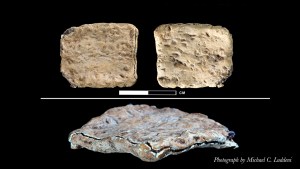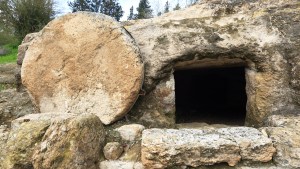For centuries, a major archaeological find was waiting in the corner of Jerusalem’s Church of the Holy Sepulchre. An enormous stone slab marked with the centuries-old graffiti of pilgrims has been revealed to be the remains of the original medieval altar, used in the sanctuary until 1808.
A report from the Times of Israel explains that the slab was overlooked for so long because it was placed on the floor upside down. For over 200 years the unassuming rock attracted graffiti from visiting faithful who wished to leave their mark on its smooth surface. The ornamented side was only discovered thanks to a round of renovations currently underway at the famed Jerusalem church.
Jerusalem’s regional archaeologist for the Israel Antiquities Authority, Amit Re’em, called the discovery “a fascinating case.” He told Reuters:
“You cannot see it now, but originally it was inlaid with pieces of precious marble, pieces of glass, pieces of small, finely made marble.” The expert added, “It was shining and this was a really amazing artifact.”
Cosmatesque style
Reuters goes on to identify the artistic style of the altar as “Cosmatesque,” a combination of the classical, Byzantine and early Islamic artistic styles. Similar to a mosaic, the Cosmatesque style fills in circular engravings on the rock with tiles of colorful marble and glass.
Previously discovered examples of the Cosmatesque style in Jerusalem have been dated between the 12th and 13th centuries, which may be when the altar was created. Experts believe that the altar was used by Catholic clergymen during the Crusades and the Greek Orthodox until it was damaged by a fire in the early 19th century.
Historical artwork
CNN highlighted the remarks of the chief secretary of the Greek Orthodox Patriarchate of Jerusalem, Archbishop Aristarchos of Constantina, who hailed the artistic value of the ancient altar:
“Works from people of art, people of archaeology, contribute to us, contribute to the belief of the church, to the conviction of the church, that this is the place…on which Jesus Christ was crucified…buried and from which he came to resurrection.”
A full report of the findings of the Israel Exploration Society is forthcoming. There has been no mention of what will become of the medieval altar, but it could be restored and replaced in the Church of the Holy Sepulchre’s sanctuary, or perhaps displayed as a historical artifact.


